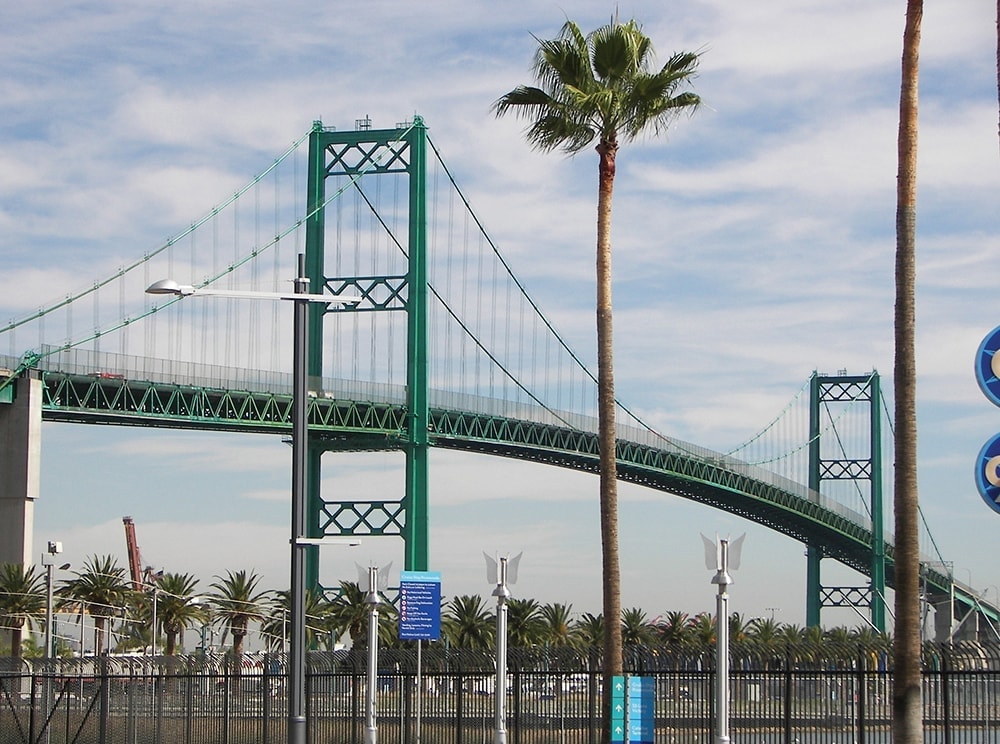We’re hearing a lot about “infrastructure” these days, and if you live in San Pedro, nothing says infrastructure like the roads leading to and from the ports of Los Angeles and Long Beach.
Now that the Heim Bridge connecting Wilmington and Terminal Island has been replaced by an expanded State Route 47 and the beautiful new bridge connecting Terminal Island to Long Beach has been completed, it’s only natural to cast a wary eye at the Vincent Thomas Bridge. The Long Beach project brought horrific delays and detours for thousands of commuters, not to mention untold thousands of semitrailer drivers hauling containers to and from the twin ports, and it’s hard to believe that the same scenario can be avoided in San Pedro’s near future. The Desmond was not only outdated, but it was also unsafe, and it was five years younger than the VTB, which opened in 1963.
The prospect of replacing the VTB with a bridge able to meet the needs of the nation’s largest harbor complex (at least four lanes each way) is a daunting one. Still, anyone using the bridge today knows the status quo has become untenable — unless you happen to work for Caltrans, which is in charge of that vital span over the Main Channel.
You wouldn’t think that you’d need a degree in traffic engineering to know that the VTB is wholly inadequate for handling today’s transportation requirements, but you’d be wrong. At least, that was the impression I received when I contacted a Caltrans official in response to an article that said the VTB had reached “capacity” in 2010.
Asked to explain that, the anonymous Caltrans emailer wrote, “Vincent Thomas Bridge has two lanes in each direction and based on the latest available traffic volume data, the mainline (or ‘through lanes’) capacity is able to handle the traffic demand.”
In the next sentence, however, Caltrans says, “Currently, at the west end of Vincent Thomas Bridge (at the interchange of State Route 47 at Harbor Boulevard), traffic routinely backs up on both off-ramps during peak periods, and this condition is expected to worsen with projected growth.” The “peak periods” of this nightmare situation are roughly all day — and does that “growth” even take into account what weekends will be like when the new San Pedro Fish Market opens at that very intersection?
The port and city are working on a project “to reconfigure the interchange to improve safety and operation for vehicles exiting the highway… expected to go out to bid in 2022.” It sounds like traffic headaches will be continuing for some time.
The problem with all of the Terminal Island bridges is that they were built in the pre-container era. In other words, they weren’t built to handle a constant stream of 18-wheelers hauling 40-foot containers to and from terminals. And even though the Desmond and VTB could handle those heavy loads, no one envisioned the day when two lanes each way would simply not be sufficient.
Caltrans’ most recent traffic figures (2018) show 53,000 vehicles a day at the west end of VTB. The total number of trucks was 4,664, 8.8 percent of the total traffic, and of that total, only 1,910 were trucks with five or more axles.
One might think, well, that’s not too bad, but one of my all-time favorite quotes remains, “There are lies, damned lies, and statistics.” The ports have been setting records nearly every month for numbers of containers moved, so we know that the 2018 numbers have dramatically increased. But even at the 2018 rate, the numbers are misleading because how often are both lanes going in each direction open? Because of the abuse the bridge has taken for so many years at “capacity,” maintenance is nearly continual. That means on a two-lane bridge, one lane is closed, and it’s always at those “peak hours.” And that doesn’t figure in the way-too-frequent accident or simple breakdown of an 18-wheeler. With those semis crawling up the bridge at 10 mph, traffic backs up for miles. Even with both lanes open, traffic often bottlenecks because no one enforces the rule of slower traffic (read trucks) staying in the far right lane.
Finally, the question certainly on the mind of every commuter (or at least mine) when the “Lane Closed Ahead” signs are up at “peak hours” is why doesn’t Caltrans do its maintenance/repair work in the off-hours?
The response from Caltrans is, “Our highway workers are most at risk when traffic speeds are the highest. This would be the hours of darkness. We do our best to ensure all our lane closures are posted to Waze and the other apps to help minimize the impact to traffic. We are committed to keeping all our bridges — including the Vincent Thomas Bridge — open, safe, and beautiful for the public.”
Is Caltrans saying that nightside longies drive too fast?
The reality on the ground is that posting closures don’t help because there are no good alternates. For instance, if you live in San Pedro and can’t make it over the bridge, the only workaround is Anaheim to State Route 47. In other words, a 10-minute trip turns into a 20-minute trip — if you don’t run into any trains along the way.
Trains. Don’t get me started. spt







Comments